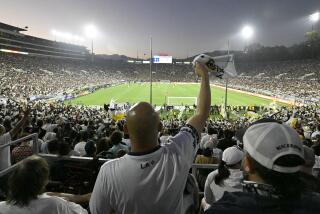The NFL tries to make fans feel more at home, and get them out of the home
Reporting from New Orleans — Football fans will tune in this season, but will they turn out?
That’s what the NFL is asking as it heads into the first weekend of the 2010 season, with TV viewership continuing to reach new heights but the league bracing for a dip in attendance for a third consecutive year.
With season-ticket sales down 5% from last year, and a projected 1% to 2% decline in overall attendance on the horizon, league officials are predicting the lowest average attendance since 1998. The average attendance last season was 65,043.
That’s not to say the game is losing popularity. On the contrary, viewership numbers are up across the board. Fox, NBC, ESPN and the NFL Network all had their most-watched NFL regular-season games in 2009, and CBS had its best season since 1993.
The sluggish economy is a big reason fans are staying home — the average ticket price rose 3.9% to $74.99 last season, according to Team Market Report — but millions of people also realize it’s more comfortable and convenient to watch from their homes.
“We’re still in a challenging environment,” NFL Commissioner Roger Goodell said. “We obviously see what our fans are going through. There is still a lot of uncertainty out there in our fans’ minds. That’s reflected in their willingness to commit to season tickets. We’re having to work harder and spend more resources to get our fans to engage.”
It’s a situation that only stands to get worse for the league, as high-definition TVs become more affordable and with 3-D broadcasts just around the corner. What’s more, the popularity of fantasy football means that millions of fans are interested not just in what’s happening with their team, but what’s going on all over the league — something that’s easier to monitor at home.
Dallas Cowboys owner Jerry Jones, who last season opened a $1.2-billion stadium with a colossal video board stretching from one 20-yard line to the other, said the NFL “cannot become a studio game” and maintain its popularity.
“If you had a game on TV that didn’t have the pageantry of the crowds and the stadiums, people see that,” Jones said. “Think about if you were sitting at home watching a game with 15,000 people watching it [in the stadium]. Wouldn’t be the same game.”
Jones said that he could have spent $400 million less on his stadium and still built a functional venue, but that he made the extra investment to enhance the fan experience.
Not all NFL owners embrace that philosophy.
“We’ve got owners who have stood up and said, ‘New stadiums are bad business. All they do is get everybody on the treadmill, trying to catch up.’ So we’ve got owners who haven’t been pro-marketing,” Jones said.
Jones isn’t the only owner with a vital interest in keeping the turnstiles spinning. There are new and renovated stadiums all over the NFL, and Sunday will mark the first regular-season game at the New Meadowlands, home of the New York Giants and Jets. At a construction cost of $1.6 billion, it’s the most costly U.S. stadium in history.
“We focused not just on the style of the architecture and the beauty of the building — honestly, that’s kind of secondary — but on the amenities and services that you have to offer to the fans to enhance their experience so they want to come to the games,” said Mike Stevens, the Giants’ chief marketing officer.
That means improvements such as four times as many bathrooms and points of food and souvenir sales in comparison with the old stadium, better roads and parking, full-time rail service and massive HD video screens.
“Everybody focuses on how many seats and suites and club seats you have,” Stevens said. “But it’s really the total customer experience and all the different things you have to do to really ease the pain of a fan, and all the obstacles they have to go through for a game day to make it a more enjoyable experience.”
Among the changes in stadiums around the league this season:
—The NFL’s RedZone Channel, which drops in on games in crucial moments, will be featured on scoreboards before, during and after games.
—New HD boards have been installed in Baltimore, New England and Washington.
—The league has changed its policy to allow more fan-generated noise during games. Teams are no longer banned from putting messages such as “Raise the Roof!” and “Pump It Up!” on scoreboards, or creating visual noise meters.
—Several stadiums will offer hand-held, in-game video devices that allow spectators to watch all games.
—A fan-conduct policy has been put in place to make games more of a family experience.
Jones, for one, is betting there will always be high demand for seeing games in person, despite this season’s predicted attendance dip.
“Events can be more dramatic in a stadium than they can be at home,” he said. “Movies found that out when people did all these big home-entertainment centers in houses. They can have ‘Silence of the Lambs’ first-run in one of those centers, and the 20 or so people in there not have the feeling that you have in a big theater with a lot of people around you.
“There’s just a dynamic that goes with the event.”
sam.farmer@latimes.com
More to Read
Go beyond the scoreboard
Get the latest on L.A.'s teams in the daily Sports Report newsletter.
You may occasionally receive promotional content from the Los Angeles Times.











